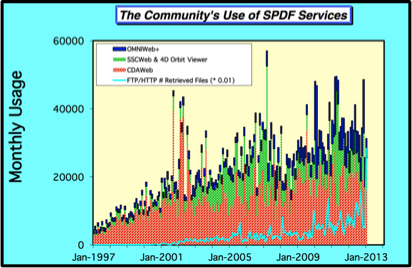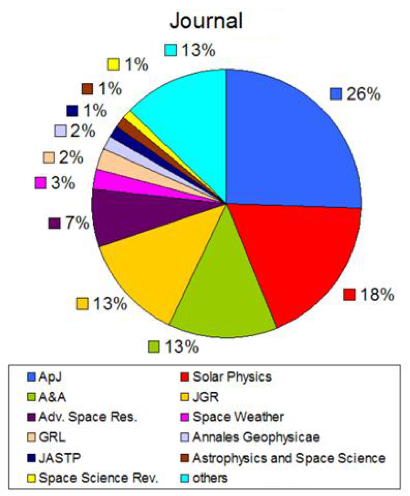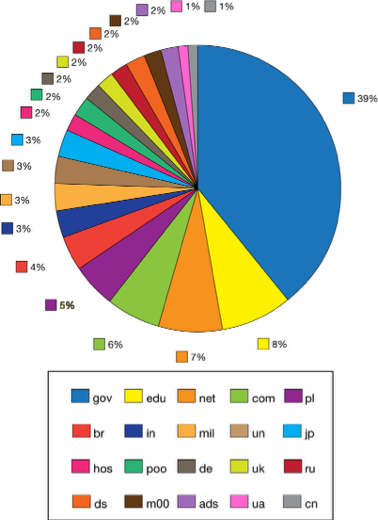HSD Information Systems
HSD Information Systems
Science information systems in the HSD range from active final archives supporting data from large numbers of missions to single instrument science data production efforts. All these systems are critical to the scientific success of NASA heliophysics missions and provide for the widest possible dissemination of fully described mission data sets to the international science community. In addition, HSD staff often advise NASA HQ in the formulation of standards and heliophysics information architecture, e.g., development of the NASA Heliophysics Science Data Management Policy (HSDMP, see http://hpde.gsfc.nasa.gov).
Final Archives
The HSDMP established two active Final Archives, both in HSD, that are responsible for preserving and ensuring long-term online availability and usability of data products from missions often past their primary science phase while providing support to the community for the proper use of the data.
Space Physics Data Facility (SPDF, R. McGuire Project Scientist). The SPDF isthe active final archive for all non-solar heliophysics mission data. It now holds data from all major operating missions and has taken responsibility in 2012 from the National Space Science Data Center (NSSDC) for data from older missions that were online at NSSDC. SPDF operates web-based services that promote correlative and collaborative research across discipline and mission boundaries. These include browse/display services for survey and high-resolution data (e.g., the popular CDAWeb service at http://cdaweb.gsfc.nasa.gov), the OMNI database of inferred solar wind parameters and other indices at the bow of earth’s magnetosphere (http://omniweb.gsfc.nasa.gov) and spacecraft trajectory displays and listings (e.g through SSCWeb and the 4D Orbit Viewer Java application at http://sscweb.gsfc.nasa.gov). SPDF’s services are heavily used by the heliophysics community and have been acknowledged e.g in ~20% of the papers published in the Journal of Geophysical Research: Space Physics (154 of 708 papers in 2012) in each of the last 4 years.

To enable more effective archiving and the use of common tools for data display and analysis, SPDF also develops and maintains the Common Data Format (CDF) software, which is increasingly a standard self-describing data format for non-solar heliophysics data products. Most recently, CDF has been a standard for the THEMIS probes and the very recently launched Van Allen Probes; CDF has been selected as a data standard by the upcoming MMS and Solar Probe Plus projects. And SPDF supports the HDP/VSPO (Heliophysics Data Portal / Virtual Space Physics Observatory) interface, which builds on the work of the developing heliophysics Virtual Observatories to describe and link to all publicly available NASA and NASA science research relevant data.
Solar Data Analysis Center (SDAC, J. Gurman, Facility Scientist). SDAC is the active final archive for NASA heliophysics solar data products (http://umbra.nascom.nasa.gov). SDAC supports Solar Dynamics Observatory, SOHO, solar instruments on STEREO, and data from TRACE, Hinode, and a number of other missions. SDAC is a major element of the distributed heliophysics Virtual Solar Observatory.
The Heliophysics Data and Modeling Consortium (HDMC)
The newest part of the heliophysics data environment is the HDMC, which is responsible for organizing aspects of the data environment that do not fit into the conventional data center mold. These include Resident Archives for continuing the serving of data after missions end and before final archiving, Data Upgrades for making older data more useful, and Virtual discipline Observatories (VxOs) for providing uniform access to, common and detailed documentation of, and advanced services for data from the various HP sub-disciplines. The Project Scientist for the HDMC is D. A. Roberts of Code 672; he is responsible for the integration of the various efforts, as well as for logistics of running a group with projects located across the country. The HSD is the home for many of the newly developed Virtual Observatories:
- Virtual Solar Observatory (VSO)- J. Gurman (PI)
- Virtual Heliospheric Observatory (VHO)-A. Szabo (PI)
- Virtual Magnetospheric Observatory (VMO/G)- J. Merka (PI)
- Virtual Energetic Particles Observatory (VEPO)- J. Cooper (PI)
- Virtual Wave Observatory- S. Fung (PI)
- Heliospheric Event List Manager (HELM) - R. Candey (PI)
and involved in other VxO efforts. While these VxOs are still being developed, they are already active and serving hundreds of commonly used heliophysics data products. The VxOs offer significantly expanded and uniform descriptions, accessible through a query interface that allows simultaneous complicated searches over multiple data sets. Development activities also include seamlessly connecting the various VxOs and incorporating event lists into the data query process.
Mission and Instrument Data Facilities
A core science information system activity in HSD is processing science data from individual mission and instrument telemetry into science quality data. HSD provides critical support for the SDO distributed science archive and distribution system. HSD is the home for the STEREO Science Center (SSC) and for the Wind-Geotail ground data systems. These produce instrument level zero files, archiving spacecraft housekeeping and orbit/ attitude information, and monitoring real-time observations and commanding.
Individual science teams then process science quality data products. HPD is home for the Voyager magnetometer (MAG) and cosmic ray experiment (CRS) data production along with the Wind magnetometer (MFI), Wind and STEREO radio and plasma waves experiments and C/NOFS CINDI data production.
The CDAW Data Center
The CDAW Data Center is a repository of information on coronal mass ejections (CMEs) observed by SOHO along with details on the associated phenomena such as flares, EUV transients, solar energetic particle (SEP) events, and geomagnetic storms. The main feature of the CDAW Data Center is the on-line catalog of all CMEs detected manually in the Large Angle and Spectrometric Coronagraph (LASCO) images. The CME attributes have been measured, and the characteristics are listed in the SOHO/LASCO CME catalog. Composite plots containing SEP intensity and Dst index along with CME height-time plots and GOES soft X-ray flux with the heliographic coordinates of the flares enable solar-terrestrial research. CME movies with Wind/WAVES dynamic spectra and GOES X-ray flares help identify CMEs associated with flares and type II radio bursts. These data products have been extensively used by the Space Weather and Living with a Star (LWS) communities because disparate data sets are pieced together in a format easily usable by non-specialists.

Distribution of publications among major journals.
The extensive community use is evidenced by the number of publications that explicitly acknowledge the data usage from the catalog. The figure above shows the nearly 1000 papers published in these refereed journals from 2002 through 2012, at an average rate of 90 papers per year.
These papers are listed at: http://cdaw.gsfc.nasa.gov/publications/catalog papers.htm. The refereed publications appeared mostly (70%) in the following journals: Astrophysical Journal (26%), Solar Physics (18%), The Journal of Geophysical Research (13%) and Astronomy and Astrophysics (13%). These journals are heavily used by the LWS and Space Weather communities. Thus the CME data products made available at the CDAW Data Center have been highly effective in enabling scientific activity in the United States and abroad.
The CDAW Data Center also contains many concise catalogs tailored to special populations of CMEs that result in significant disturbances in the heliosphere.
- The Halo CME catalog lists all full halo CMEs detected by LASCO. There are nearly 500 halo CMEs in this catalog with measurements, plots, and movies similar to the main CME catalog.
- The Wind/WAVES type II burst catalog contains all the CMEs that produced a type II radio burst observed by the Wind spacecraft. These are CMEs driving shocks near the Sun. Future plans include creating catalogs of SEP-producing CMEs and geoeffective CMEs.

Top 20 domains accessing the CME catalog in a sample month. The most frequent access to the CDAW Data Center is from U.S.Government domains followed by .edu, .net, and .com.
JavaScript-driven movies featuring various combinations of STEREO images are also routinely produced and made available online at the CDAW Data Center. The CDAW Center also contains data that formed the basis of many Coordinated Data Analysis Workshops since 1999. These data have been checked by a large number of people and hence are useful to young researchers. The plots, movies, and images available at the CDAW Data Center are heavily used by educators and teachers and by scientists for presentations because they are "ppt" ready.
The core team that runs the CDAW Data Center are Nat Gopalswamy (671, Team lead), S. Yashiro (671), G. Michalek (Jagillonian University, Poland), P. Makela (671), and A. Vourlidas (NRL). The work was supported in the past by the Air Force Office of Scientific Research (AFOSR), the National Science Foundation (NSF), and NASA. Currently the support is from NASA and Jagillonian University in Poland.
